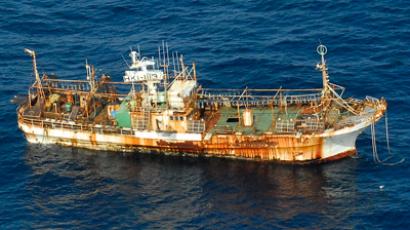Wish it away: US government ignores archipelago of Japanese debris heading its way

The United States is awaiting the arrival of a blot of debris three times its own size from Japan. But despite new objects washing up daily on the West Coast, Washington is hoping the problem will literally just disappear.
Earlier this week, a 70-foot metal dock turned up on the Oregon shore. Japanese officials immediately identified its original home – the Japanese city of Misawa, which had been devastated by the tsunami in March 2011.The dock is only the forerunner of a much more dangerous wave of flotsam, Chris Pallister, who heads Gulf of Alaska Keeper, a coastal clean-up organization, told AP."There are going to be a lot of drums full of chemicals that we won't be able to identify.""I think this is far worse than any oil spill that we've ever faced on the West Coast or any other environmental disaster we've faced on the West Coast," continued Pallister, comparing the debris to the Exxon Valdez spill that devastated the region in 1989.West Coast politicians echoed the concerns of environmentalists, with Alaskan Democratic Senator Mark Begich calling the drift a “national emergency.”He says the cleanup could cost $45 million.But the National Oceanic and Atmospheric Administration's National Ocean Service (NOAA) – the organization responsible for such emergencies – only has $618,000 dedicated to tsunami debris removal.In fact, NOAA’s entire budget is less than a tenth of the amount of necessary funds. It has said that it will be up to individual states to save their own beaches.In turn, considering the unpredictability of where the flotsam will land, individual states are hoping that the national government will create a central program from which resources can be allocated as needed.So, why hasn’t the US government created such a program?While an estimated 1.5 million tons of objects were dislodged by the tsunami – an equivalent of over 200 Eiffel Towers in weight – officials are hoping not all of it will hit the coast, and that what does hit will be spread out over time.Some of the debris has descended to the bottom of the ocean, while other pieces have been at the mercy of swirling Pacific currents that may have redirected them away from the coast. The size and weight of the debris also impacts their speed – even those destined for the US may take years to get there, rendering any targeted clean-up operation redundant.These are the best-case scenarios. The worst-case could see a mass of dangerous and personal objects (including human remains) wash up on the beaches of California, Oregon and Washington State within the space of several months, turning them into grotesque and deserted exhibitions.John Chapman from Oregon State University's Hatfield Marine Science Center said the number of objects headed towards American shores is “incredibly had to predict.”The actual scale of the problem will be evident by autumn, when the main mass of debris should reach the US.With thousands of cleanup workers needed over thousands of miles of coastland, it will take millions of dollars and months to organize a centralized program.If the authorities want to guarantee that US beaches are clean and safe, there is not much time left.














